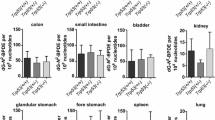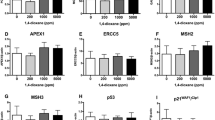Abstract
Wy-14,643 (WY), a peroxisome proliferator-activated receptor-alpha agonist, and piperonyl butoxide (PBO), a pesticide synergist, induce oxidative stress and promote hepatocarcinogenesis in the liver of rodents. These chemicals belong to a class of non-genotoxic carcinogens, but DNA damage secondary to the oxidative stress resulting from reactive oxygen species generation is suspected in rodents given these chemicals. To examine whether WY or PBO have DNA-damaging potential in livers of rats subjected to repeated oral administration for 14 days, the in vivo liver comet assay was performed in partially hepatectomized rats, and the expression of some DNA-repair genes was examined. Then, to examine whether they have genotoxic potential, the in vivo liver initiation assay was performed in rats. In the comet assay, positive results were obtained at 3 h after the last treatment of WY, and some DNA-repair genes such as Apex1, Mlh1, Xrcc5, and Gadd45 were up-regulated in the liver. In the liver initiation assay, negative results were obtained for both WY and PBO. The results of the present study suggest that WY, but not PBO, causes some DNA damage in livers of rats, but such DNA damage was repaired by the increased activity of some DNA repair genes and may not lead to a DNA mutation.



Similar content being viewed by others
References
Beamand JA, Price RJ, Phillips JC, Butler WH, Jones GD, Osimitz TG, Gabriel KL, Preiss FJ, Lake BG (1996) Lack of effect of piperonyl butoxide on unscheduled DNA synthesis in precision-cut human liver slices. Mutat Res 371:273–282
Deutsch WA, Kukreja A, Shane B, Hegde V (2001) Phenobarbital, oxazepam and Wyeth 14, 643 cause DNA damage as measured by the Comet assay. Mutagenesis 16:439–442
Fairbairn DW, Olive PL, O’Neill KL (1995) The comet assay: a comprehensive review. Mutat Res 339:37–59
Glauert HP, Reddy JK, Kennan WS, Sattler GL, Rao VS, Pitot HC (1984) Effect of hypolipidemic peroxisome proliferators on unscheduled DNA synthesis in cultured hepatocytes and on mutagenesis in Salmonella. Cancer Lett 24:147–156
Hasegawa R, Yoshida T, Mizoguchi Y, Futakuchi M, Kim DJ, Cui L, Ito N (1994) Phenotypic alteration of hepatocellular foci in rats treated with clofibrate and phenobarbital. Cancer Lett 83:89–95
Hirata A, Tsukamoto T, Sakai H, Takasu S, Ban H, Imai T, Totsuka Y, Nishigaki R, Wakabayashi K, Yanai T, Masegi T, Tatematsu M (2008) Carcinogenic risk of heterocyclic amines in combination—assessment with a liver initiation model. Food Chem Toxicol 46:2003–2009
Jin M, Dewa Y, Kawai M, Nishimura J, Saegusa Y, Matsumoto S, Harada T, Shibutani M, Mitsumori K (2009) Induction of liver preneoplastic foci in F344 rats subjected to 28-day oral administration of diheptyl phthalate and its in vivo genotoxic potential. Toxicology 264:16–25
Kasai H (1997) Analysis of a form of oxidative DNA damage, 8-hydroxy-2’-deoxyguanosine, as a marker of cellular oxidative stress during carcinogenesis. Mutat Res 387:147–163
Klaunig JE, Kamendulis LM (2004) The role of oxidative stress in carcinogenesis. Annu Rev Pharmacol Toxicol 44:239–267
Marsman DS, Cattley RC, Conway JG, Popp JA (1988) Relationship of hepatic peroxisome proliferation and replicative DNA synthesis to the hepatocarcinogenicity of the peroxisome proliferators di(2-ethylhexyl)phthalate and [4-chloro-6- (2, 3-xylidino)- 2-pyrimidinylthio]acetic acid (Wy-14, 643) in rats. Cancer Res 48:6739–6744
Moto M, Sasaki YF, Okamura M, Fujita M, Kashida Y, Machida N, Mitsumori K (2003) Absence of in vivo genotoxicity and liver initiation activity of dicyclanil. J Toxicol Sci 28:173–179
Muguruma M, Unami A, Kanki M, Kuroiwa Y, Nishimura J, Dewa Y, Umemura T, Oishi Y, Mitsumori K (2007) Possible involvement of oxidative stress in piperonyl butoxide induced hepatocarcinogenesis in rats. Toxicology 236:61–75
Muguruma M, Kawai M, Dewa Y, Nishimura J, Saegusa Y, Yasuno H, Jin M, Matsumoto S, Takabatake M, Arai K, Mitsumori K (2009) Threshold dose of piperonyl butoxide that induces reactive oxygen species-mediated hepatocarcinogenesis in rats. Arch Toxicol 83:183–193
Nishikawa T, Wanibuchi H, Ogawa M, Kinoshita A, Morimura K, Hiroi T, Funae Y, Kishida H, Nakae D, Fukushima S (2002) Promoting effects of monomethylarsonic acid, dimethylarsinic acid and trimethylarsine oxide on induction of rat liver preneoplastic glutathione S-transferase placental form positive foci: a possible reactive oxygen species mechanism. Int J Cancer 100:136–139
Nishimura J, Dewa Y, Okamura T, Muguruma M, Jim M, Saegusa Y, Umemura T, Mitsumori K (2008) Possible involvement of oxidative stress in fenofibrate-induced hepatocarcinogenesis in rats. Arch Toxicol 82:641–654
Peters JM, Cattley RC, Gonzalez FJ (1997) Role of PPAR alpha in the mechanism of action of the nongenotoxic carcinogen and peroxisome proliferator Wy-14, 643. Carcinogenesis 18:2029–2033
Peters JM, Cheung C, Gonzalez FJ (2005) Peroxisome proliferator-activated receptor-α and liver cancer: where do we stand? J Mol Med 83:774–785
Pogribny IP, Tryndyak VP, Boureiko A, Melnyk S, Bagnyukova TV, Montgomery B, Rusyn I (2008) Mechanisms of peroxisome proliferator-induced DNA hypomethylation in rat liver. Mutat Res 644:17–23
Puntarulo S, Cederbaum AI (1998) Production of reactive oxygen species by microsomes enriched in specific human cytochrome P450 enzymes. Free Radic Biol Med 24:1324–1330
Rao MS, Reddy JK (1987) Peroxisome proliferation and hepatocarcinogenesis. Carcinogenesis 8:631–636
Rao MS, Nemali MR, Usuda N, Scarpelli DG, Makino T, Pitot HC, Reddy JK (1988) Lack of expression of glutathione-S-transferase P, gamma-flutamyl transpeptidase, and alpha-fetoprotein messenger RNAs in liver tumors induced by peroxisome proliferators. Cancer Res 48:4919–4925
Reddy JK, Rao MS (1989) Oxidative DNA damage caused by persistent peroxisome proliferation: its role in hepatocarcinogenesis. Mutat Res 214:63–68
Sakai H, Tsukamoto T, Yamamoto M, Yanai T, Masegi T, Inada K, Nakanishi H, Tatematsu M (2000) Summation of initiation activities of low doses of the non-hepatocarcinogen 1, 2-dimethylhydrazine in the liver after carbon tetrachloride administration. Cancer Lett 148:59–63
Sakai H, Tsukamoto T, Yamamoto M, Kobayashi K, Yuasa H, Imai T, Yanai T, Masegi T, Tatematsu M (2002) Distinction of carcinogens from mutagens by induction of liver cell foci in a model for detection of initiation activity. Cancer Lett 188:33–38
Sano M, Hagiwara A, Tamano S, Hasegawa R, Imaida K, Ito N, Shirai T (1999) Dose-dependent induction of carcinomas and flutathione S-transferase placental form negative eosinophilic foci in the rat liver by di(2-ethylhexyl) phthalate after diethylnitrosamine initiation. J Toxicol Sci 24:177–186
Sasaki Y, Ueno S, Miyamae Y, Ohta T, Tsuda S (1998) Detection of organ specific genotoxicity by alkaline single cell gel electrophoresis assay with mouse multiple organs. Environ Mutagen Res 20:51–62
Seo KW, Kim KB, Kim YJ, Choi JY, Lee KT, Choi KS (2004) Comparison of oxidative stress and changes of xenobiotic metabolizing enzymes induced by phthalates in rats. Food Chem Toxicol 42:107–114
Shane BS, Smith-Dunn DL, Ganesh L, Cunningham ML (1999) Mutagenicity of Wyeth 14,643 in vivo in the liver of Big Blue transgenic mice. Proc Am Assoc Cancer Res 39:241
Shane BS, Smith-Dunn DL, deBoer JG, Glickman BW, Cunningham ML (2000) Subchronic administration of phenobarbital alters the mutation spectrum of lacI in the livers of Big Blue transgenic mice. Mutat Res 448:69–89
Singh VK, Ganesh L, Cunningham ML, Shane BS (2001) Comparison of the mutant frequencies and mutation spectra of three non-genotoxic carcinogens, oxazepam, phenobarbital, and Wyeth 14, 643, at the lambdacII locus in Big Blue transgenic mice. Biochem Pharmacol 62:685–692
Takahashi O, Oishi S, Fujitani T, Tanaka T, Yoneyama M (1994) Chronic toxicity studies of piperonyl butoxide in F344 rats: induction of hepatocellular carcinoma. Fundam Appl Toxicol 22:293–303
Tsuda H, Lee G, Farber E (1980) Induction of resistant hepatocytes as a new principle for a possible short-term in vivo test for carcinogens. Cancer Res 40:1157–1164
Valavanidis A, Vlachogianni T, Fiotakis C (2009) 8-hydroxy-2′ -deoxyguanosine (8-OHdG): a critical biomarker of oxidative stress and carcinogenesis. J Environ Sci Health Part C Environ Carcinog Ecotoxicol Rev 27:120–139
Wiklund SJ, Agurell E (2003) Aspects of design and statistical analysis in the Comet assay. Mutagenesis 18:167–175
Williams GM, Maruyama H, Tanaka T (1987) Lack of rapid initiating, promoting or sequential syncarcinogenic effects of di(2-ethylhexyl)phthalate in rat liver carcinogenesis. Carcinogenesis 8:875–880
Woods CG, Burns AM, Bradford BU, Ross PK, Kosyk O, Swenberg JA, Cunninqham ML, Rusyn I (2007) WY-14, 643 induced cell proliferation and oxidative stress in mouse liver are independent of NADPH oxidase. Toxicol Sci 98:366–374
Zahradka P (2007) Cardiovascular actions of the peroxisome proliferator-activated receptor-alpha (PPARalpha) agonist Wy14, 643. Cardiovasc Drug Rev 25:99–122
Author information
Authors and Affiliations
Corresponding author
Rights and permissions
About this article
Cite this article
Suzuki, T., Jin, M., Dewa, Y. et al. Evaluation of in vivo liver genotoxic potential of Wy-14,643 and piperonyl butoxide in rats subjected to two-week repeated oral administration. Arch Toxicol 84, 493–500 (2010). https://doi.org/10.1007/s00204-010-0516-x
Received:
Accepted:
Published:
Issue Date:
DOI: https://doi.org/10.1007/s00204-010-0516-x




